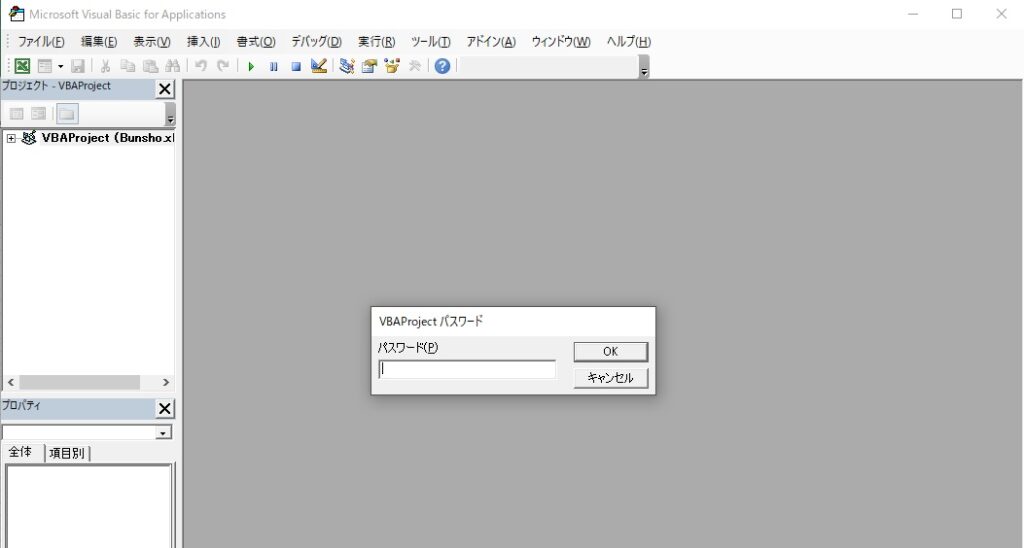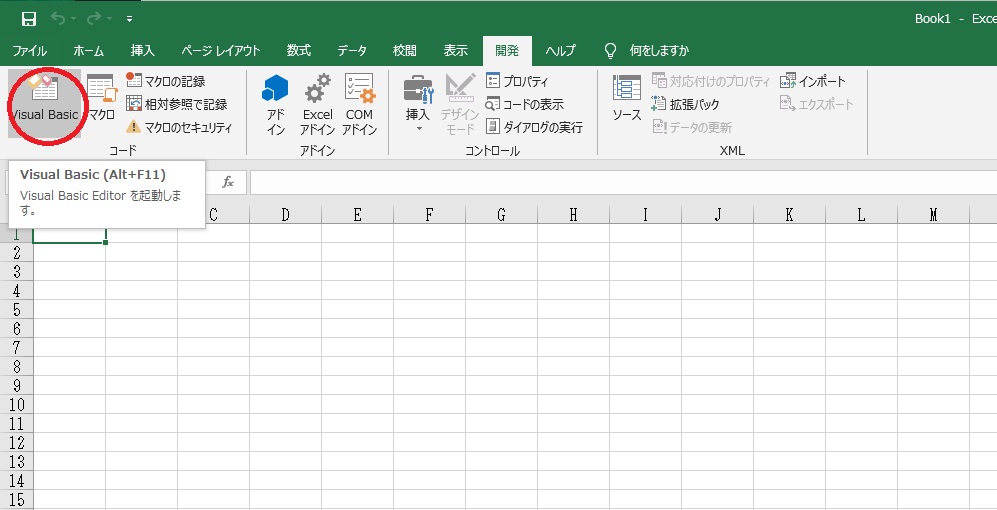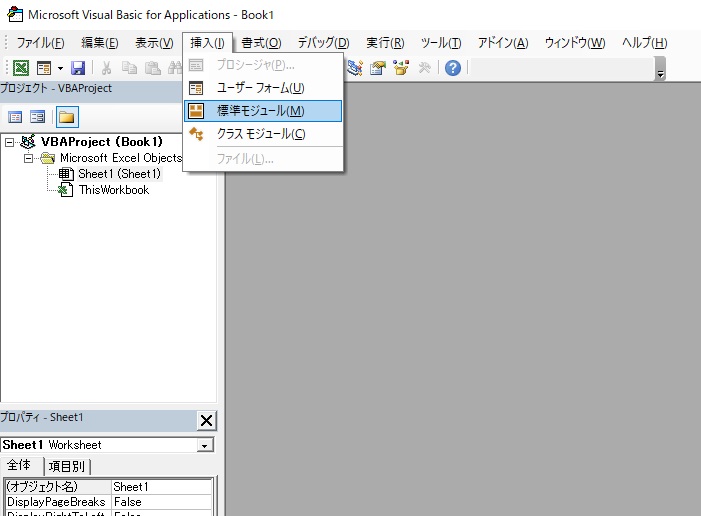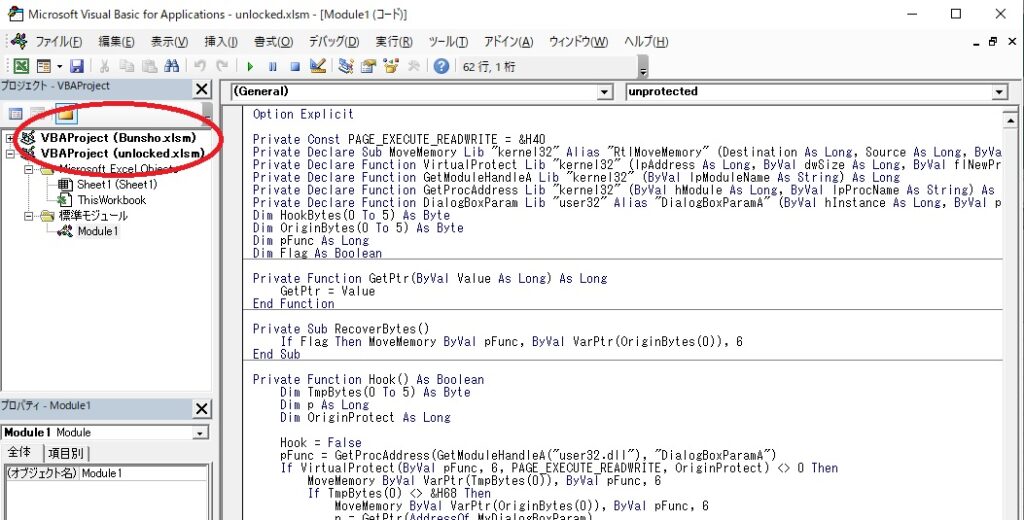Excel2016でVBAにパスワードがかかっているのを解除してVBAの内容を見れるようにします。

解除用のExcelファイルを作成する
Excelを起動して「空白のブック」を作成します。

「Visual Basic」を選択します。

「Visual Basic」画面が立ち上がるので「挿入」から「標準モジュール」を選択します。

「Module 1」に以下の内容をコピペします。
32bit版
Option Explicit
Private Const PAGE_EXECUTE_READWRITE = &H40
Private Declare Sub MoveMemory Lib "kernel32" Alias "RtlMoveMemory" (Destination As Long, Source As Long, ByVal Length As Long)
Private Declare Function VirtualProtect Lib "kernel32" (lpAddress As Long, ByVal dwSize As Long, ByVal flNewProtect As Long, lpflOldProtect As Long) As Long
Private Declare Function GetModuleHandleA Lib "kernel32" (ByVal lpModuleName As String) As Long
Private Declare Function GetProcAddress Lib "kernel32" (ByVal hModule As Long, ByVal lpProcName As String) As Long
Private Declare Function DialogBoxParam Lib "user32" Alias "DialogBoxParamA" (ByVal hInstance As Long, ByVal pTemplateName As Long, ByVal hWndParent As Long, ByVal lpDialogFunc As Long, ByVal dwInitParam As Long) As Integer
Dim HookBytes(0 To 5) As Byte
Dim OriginBytes(0 To 5) As Byte
Dim pFunc As Long
Dim Flag As Boolean
Private Function GetPtr(ByVal Value As Long) As Long
GetPtr = Value
End Function
Private Sub RecoverBytes()
If Flag Then MoveMemory ByVal pFunc, ByVal VarPtr(OriginBytes(0)), 6
End Sub
Private Function Hook() As Boolean
Dim TmpBytes(0 To 5) As Byte
Dim p As Long
Dim OriginProtect As Long
Hook = False pFunc = GetProcAddress(GetModuleHandleA("user32.dll"), "DialogBoxParamA") If VirtualProtect(ByVal pFunc, 6, PAGE_EXECUTE_READWRITE, OriginProtect) <> 0 Then MoveMemory ByVal VarPtr(TmpBytes(0)), ByVal pFunc, 6 If TmpBytes(0) <> &H68 Then MoveMemory ByVal VarPtr(OriginBytes(0)), ByVal pFunc, 6 p = GetPtr(AddressOf MyDialogBoxParam) HookBytes(0) = &H68 MoveMemory ByVal VarPtr(HookBytes(1)), ByVal VarPtr(p), 4 HookBytes(5) = &HC3 MoveMemory ByVal pFunc, ByVal VarPtr(HookBytes(0)), 6 Flag = True Hook = True End If End If
End Function
Private Function MyDialogBoxParam(ByVal hInstance As Long, ByVal pTemplateName As Long, ByVal hWndParent As Long, ByVal lpDialogFunc As Long, ByVal dwInitParam As Long) As Integer
If pTemplateName = 4070 Then
MyDialogBoxParam = 1
Else
RecoverBytes
MyDialogBoxParam = DialogBoxParam(hInstance, pTemplateName, _
hWndParent, lpDialogFunc, dwInitParam)
Hook
End If
End Function
Public Sub unprotected()
If Hook Then
MsgBox "VBA Project is unprotected!", vbInformation, "*"
End If
End Sub64bit版
Option Explicit
Private Const PAGE_EXECUTE_READWRITE = &H40
Private Declare PtrSafe Sub MoveMemory Lib "kernel32" Alias "RtlMoveMemory" (Destination As LongPtr, Source As LongPtr, ByVal Length As LongPtr)
Private Declare PtrSafe Function VirtualProtect Lib "kernel32" (lpAddress As LongPtr, ByVal dwSize As LongPtr, ByVal flNewProtect As LongPtr, lpflOldProtect As LongPtr) As LongPtr
Private Declare PtrSafe Function GetModuleHandleA Lib "kernel32" (ByVal lpModuleName As String) As LongPtr
Private Declare PtrSafe Function GetProcAddress Lib "kernel32" (ByVal hModule As LongPtr, ByVal lpProcName As String) As LongPtr
Private Declare PtrSafe Function DialogBoxParam Lib "user32" Alias "DialogBoxParamA" (ByVal hInstance As LongPtr, ByVal pTemplateName As LongPtr, ByVal hWndParent As LongPtr, ByVal lpDialogFunc As LongPtr, ByVal dwInitParam As LongPtr) As Integer
Dim HookBytes(0 To 5) As Byte
Dim OriginBytes(0 To 5) As Byte
Dim pFunc As LongPtr
Dim Flag As Boolean
Private Function GetPtr(ByVal Value As LongPtr) As LongPtr
GetPtr = Value
End Function
Private Sub RecoverBytes()
If Flag Then MoveMemory ByVal pFunc, ByVal VarPtr(OriginBytes(0)), 6
End Sub
Public Function Hook() As Boolean
Dim TmpBytes(0 To 5) As Byte
Dim p As LongPtr
Dim OriginProtect As LongPtr
Hook = False
pFunc = GetProcAddress(GetModuleHandleA("user32.dll"), "DialogBoxParamA")
If VirtualProtect(ByVal pFunc, 6, PAGE_EXECUTE_READWRITE, OriginProtect) <> 0 Then
MoveMemory ByVal VarPtr(TmpBytes(0)), ByVal pFunc, 6
If TmpBytes(0) <> &H68 Then
MoveMemory ByVal VarPtr(OriginBytes(0)), ByVal pFunc, 6
p = GetPtr(AddressOf MyDialogBoxParam)
HookBytes(0) = &H68
MoveMemory ByVal VarPtr(HookBytes(1)), ByVal VarPtr(p), 4
HookBytes(5) = &HC3
MoveMemory ByVal pFunc, ByVal VarPtr(HookBytes(0)), 6
Flag = True
Hook = True
End If
End If
End Function
Private Function MyDialogBoxParam(ByVal hInstance As LongPtr, ByVal pTemplateName As LongPtr, ByVal hWndParent As LongPtr, ByVal lpDialogFunc As LongPtr, ByVal dwInitParam As LongPtr) As Integer
If pTemplateName = 4070 Then
MyDialogBoxParam = 1
Else
RecoverBytes
MyDialogBoxParam = DialogBoxParam(hInstance, pTemplateName, hWndParent, lpDialogFunc, dwInitParam)
Hook
End If
End Function
Public Sub unprotected()
If Hook Then
MsgBox "VBA Project is unprotected!", vbInformation, "*****"
End If
End Sub貼り付けるとこんな感じになります。

デスクトップにVBA入りの空ファイルを保存します。
「unlocked.xlsm」として保存します。


VBAロックを解除する
マクロのパスワードがかかっているファイル「Bunsho.xlsm」を起動します。
「Visual Basic」を選択します。

VBAProjectを選択すると「VBA Projectパスワード」を求められます。
VBAを記述してある場所にパスワードがかかった状態です。

次に、「Bunsho.xlsm」を起動したまま、先ほど作成した「unlocked.xlsm」を起動して「Visual Basic」を見てみます。

「Module 1」を選択して実行(赤い丸)を選択してVBAを実行する。

「実行」を選択します。

無事、パスワードのロックが解除されて「Bunsho.xlsm」のVBA中身を見ることができるようになります。

VBAロックの掛け方
「Bunsho.xlsm」を開いて「Visual Basic」を選択後「ツール」から「VBAProjectのプロパティ」を選択します。

「保護」のタブから「プロジェクトのロック」にチェックを入れて、パスワードを入力し「OK」を選択するとパスワードを掛けることができます。
